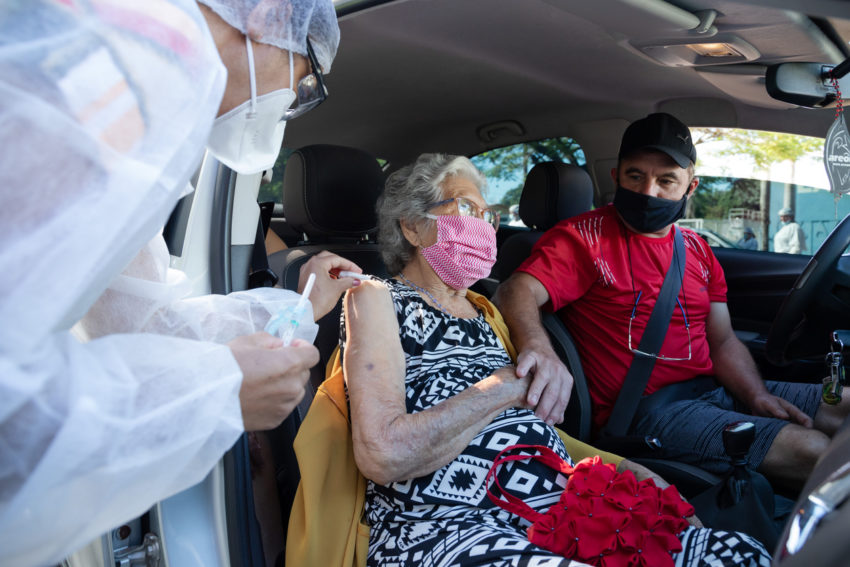
Share On Social!
The COVID-19 vaccination gap continues among Latinos.
In fact, most people who have received at least one dose of the vaccine were White (58%), while only 17% were Latino. State-level data show that Latinos are vaccinated at a much lower rate, even as they face heavier case and death burdens from the disease.
This makes it critical to find innovative ways to reach Latinos to get vaccinated.
“One of the main reasons for inequities in vaccination rates by race and ethnicity is the significant misinformation about vaccines and lack of health education,” writes Dr. Jay Bhatt, an internal medicine physician and an instructor at the University of Illinois School of Public Health, in a recent op-ed.
“Through targeted outreach, one-on-one conversations and concerted efforts addressing the needs of all of America’s diverse communities, we can beat this pandemic through inclusivity, compassion and equity.”
1. Professional Fútbol/Soccer & COVID-19 Vaccines
In a recent international fútbol game between Mexico and the U.S. national teams in Denver (29% Latino), medical experts hosted a mobile COVID-19 vaccination site.
That gave soccer fans like Oscar Filipe Sanchez an opportunity to get his vaccine during halftime.
“Perhaps no group has been harder to get vaccinated than Coloradans who identify as Latino,” John Daley with NPR writes. “Despite Latinos making up more than 20% of the state population, only about 10 percent of the state’s doses have gone to Latino residents, according to the state’s vaccination dashboard.”
In Denver, citizens recently reached the 70% vaccination threshold.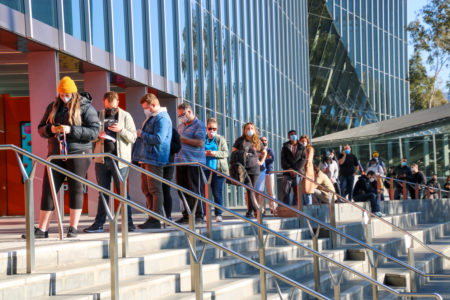
Still, some of the city’s Latino neighborhoods are getting vaccinated at much lower rates, according to Dr. Lilia Cervantes, an associate professor in the department of medicine at Denver Health.
“There are some very high-risk neighborhoods where most of the community are first-generation or foreign-born individuals,” Cervantes told NPR. “And that is where we’re seeing the highest disparities.”
Still, the soccer vaccination event made an impact.
“Horns blared, and drums pounded a constant beat as fans of the Mexican national soccer team gathered recently at Empower Field at Mile High in Denver for a high-profile, international tournament,” John Daley with NPR writes. “But the sounds were muted inside a mobile medical RV parked near the stadium, and the tone was professional.
“Bringing the mobile vaccine program to an international soccer match was the latest effort by the state of Colorado and its local partners to meet unvaccinated residents, wherever they are, rather than asking them to find the vaccine themselves.”
2. ‘King of the Streets’ Lowrider Car Show & COVID-19 Vaccines
In San Francisco (18.5% Latino), vehicle enthusiasts had the opportunity to get a COVID-19 vaccine at the 40th annual “King of the Streets” lowrider car show.
“While the usual hydraulic-propelled car-hopping contest took place, the lowrider council also came up with the idea to offer cash incentives to help reach unvaccinated folks, especially in the Latino community,” Sara Hossaini with KQED writes. “And alongside the usual arts and crafts vendors, the council provided custom-made lowrider masks.”
While attendees took in sights of bouncing cars, a vaccination clinic gave out vaccinations to those who still needed their first dose.
“It’s about being creative, just like lowriders, we’re creative,” San Francisco Lowrider Council founder Roberto Y. Hernández, told KQED. “Eventually, you’re going to need a vaccine to go to indoor events. So let’s just get everybody vaccinated so that you don’t feel deprived of not being able to participate in things that you’re used to participating in.”
3. ‘Joints for Jabs’
In Long Beach, Calif. (42.6% Latino), city leaders are using a recently deemed recreational substance to reach Latinos and other unvaccinated communities.
Last month, a local group— Healthy Long Beach—held its first “Joints for Jabs” event.
Adults older than 21 who received a vaccine also received a pre-rolled cannabis cigarette. 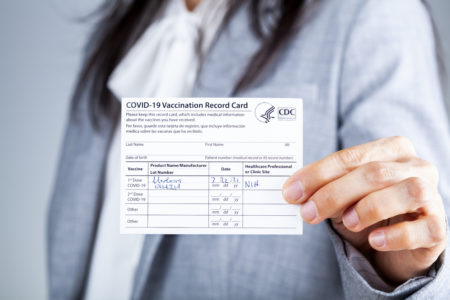
City workers at the event said more than a dozen people got shots that day, in exchange for joint vouchers or even popsicles.
The city has seen a recent rise in vaccination rates due to innovative programs like these, as there was a 50% increase, from an average of 357 to 527 doses a day.
“We know COVID has disproportionately affected the [Latino] community in Long Beach and all around the U.S.,” Amber Johnson, a health science professor at Cal State Long Beach who works with the city’s Black Health Equity team, told Long Beach News. “And it’s unveiled a lot of the long-standing disparities, not just in the difference between rates of diseases among Black people compared to other communities, but also the inequities in regards to access to healthcare.”
4. Food Pantries Providing COVID-19 Vaccines
Organización Latino Americana (OLA) in upstate New York has provided vaccines to its community in East Hampton, N.Y. (23.7% Latino).
They are specifically providing the Pfizer COVID vaccines at the city’s Northwell Health and the Springs Food Pantry.
“We’re so pleased we can continue working with Holly at the Springs Food Pantry and with the team at Northwell Health to once again bring vaccines to where so many of our community members actually live. In May and June this collaboration resulted in over 50 people, including a number of teenagers, getting fully vaccinated at the church,” said OLA Executive Director and Salud America! Salud Hero Minerva Perez.
“Our ultimate goal is to make sure that as many people as possible have access to the vaccine and understand the benefits of being fully vaccinated, both for their families and for this community we all share.”
5. Getting COVID-19 Vaccinations at a Latino Community Center
South Bethlehem, Pennsylvania’s Hispanic Center Lehigh Valley COVID-19 vaccination outreach program is making waves in its community.
The organization recently received a $100,000 grant to further its work in getting Latinos vaccinated.
“As a trusted community organization among the Hispanic/Latino community, the Hispanic Center has been able to reach individuals in their own language and break down potential barriers to vaccine access while addressing vaccine hesitancy,” Executive Director Victoria Montero said. “Funding from the CDC Foundation will allow us to expand our vaccination campaign to target specific neighborhoods in Allentown, Bethlehem, and Easton in collaboration with our community partners by mobilizing credible community voices with strong ties to our local communities.” 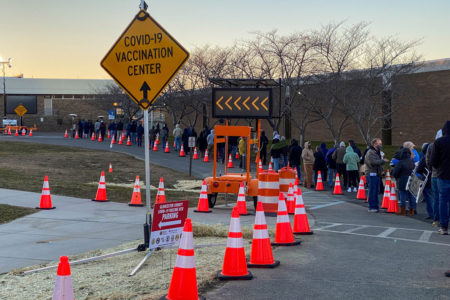
They aim to expand existing work promoting vaccination access and to address vaccine hesitancy among the Lehigh Valley’s Latino, Black, and immigrant communities.
“The Hispanic Center’s played an active role in the Lehigh Valley’s COVID-19 response since the coronavirus was first detected in Pennsylvania in March 2020, coordinating referrals and outreach for rental assistance and distributing food to more than 4,000 individuals,” Sara K. Satullo writes for Lehigh Valley Live.
“It’s hosted clinics that vaccinated more than 1,500 residents, distributed personal protective equipment to over 400 people and engaged more than 3,600 residents in a Spanish-language COVID-19 vaccine information session.”
#SayAdiosToCovid Campaign
In the Lonestar State, the Texas Association of Mexican American Chambers of Commerce (TAMACC) announced a campaign to help get Latino workers vaccinated.
The #SayAdiosToCovid initiative will aim to convince Tejano (a term for Texas citizens of Latino descent) business owners to commit to getting 100% of their workforces fully vaccinated by Nov. 30, 2021.
“COVID is a serious threat to our employees, our customers, our businesses and our community overall,” said J.R. Gonzáles, chairman of the TAMACC Foundation, the leadership training and education arm of the premier Latino business organization in Texas. “As Tejano and Tejana business leaders, we have a responsibility to bring this pandemic under control, or we’ll face yet another economic crisis.”
That’s why they also created numerous resources that can help businesses get their employees vaccinated. TAMACC also plans to announce webinars in Spanish and English to be conducted by participating chambers to share best practices with Tejano business leaders throughout the state.
This is one of the best ways to help Latino workers, Gonzáles said.
“It is not just the right thing to do, it’s also good business,” Gonzáles said. “We cannot afford another shutdown of the economy. Not when 70% of our people say they don’t have the financial reserves to cover three months of expenses if their employers close down. We know it’s not easy. Nothing worthwhile ever is. But I know we all want to get back to normal, move on and prosper. And getting as many shots in arms as we can is the best way to do that.”
7. Mobile Vans to Give Out COVID-19 Vaccines
The NIH Community Engagement Alliance (CEAL) Against COVID-19 Disparities works with many organizations to increase vaccination, especially among Latinos.
Principally, they are working with the University of Tennessee Health Science Center’s Research Center on Health Disparities, Equity, and the Exposome to distribute vaccines to their community.
This includes researching the best way to spread accurate, credible information to the public — especially in disadvantaged communities across the state.
“Throughout most of the pandemic, Tennessee has been one of the states most severely affected by COVID-19,” said Dr. Paul Juarezm director of the Health Disparities Research Center of Excellence at Meharry Medical College in Nashville. “The strategies we’ve had to develop are really regional strategies. In addition, our strategies are continually being modified in response to the ever-changing nature of the pandemic and our understanding of it.”
These researchers than partnered with the University of Tennessee Health Science Center’s School of Dentistry to deploy one of its mobile van to various community partners including organizations, churches, and schools.
With the van, the team was been able to test between 200 and 300 people in a single afternoon. The researchers say they are going to use these mobile vans to eventually distribute the vaccine.
“The Tennessee CEAL team is planning a similar strategy working with its community health center partners and the Tennessee Department of Health to ensure everyone has access to accurate, culturally and linguistically, trusted information to make an informed decision and to coordinate the delivery of vaccines to vulnerable communities in the coming months,” Juarez said.
8. “Juntos, We Can Stop COVID-19” digital communication campaign
COVID-19 continues to disproportionately impact Latinos, killing over 100,000 and hospitalizing many more of our mothers, fathers, children, and grandparents.
That is why Salud America! at UT Health San Antonio is launching the “Juntos, We Can Stop COVID-19” digital communication campaign in English and Spanish to help Latino families take action to slow the spread of coronavirus, especially among those with underlying illnesses. 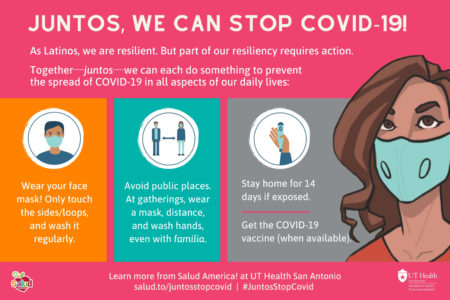
“As Latinos, we are resilient. But part of our resiliency requires action, like getting the COVID-19 vaccine when it becomes available to you,” said Dr. Amelie G. Ramirez, director of the campaign and Salud America! at the Institute for Health Promotion Research at UT Health San Antonio. “Vaccines help our bodies become immune to a virus without becoming ill from it. Vaccination is an important way we can stop the pandemic once and for all.”
The #JuntosStopCovid campaign centers on four main preventive actions:
- Wear a face mask—and care for it properly.
- Avoid public places, or at least get together safely, familia.
- Know what to do if you’re exposed, or test positive.
- Get the COVID-19 vaccine (when available).
“We all have someone we love and care about whose health is at greater risk if they get COVID-19. That’s why we created this campaign,” Ramirez said. “We want to encourage families and communities all over to take action and spread the word about these important safety measures with family, friends, and co-workers. Let’s save our families.”
SHARE THE CAMPAIGN IN ENGLISH!
SHARE THE CAMPAIGN IN SPANISH!
Explore More:
COVID-19By The Numbers
142
Percent
Expected rise in Latino cancer cases in coming years

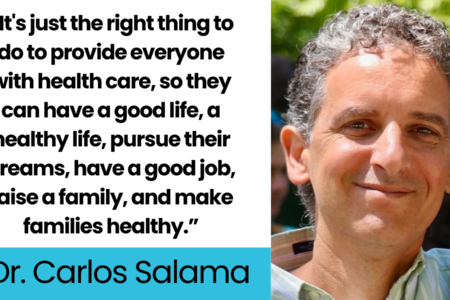

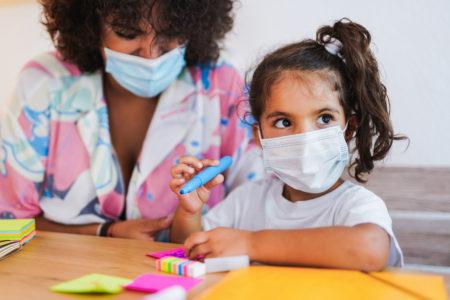
[…] The pandemic is another chapter in the bitter story of American racism and inequality. Black and Latinx people are being infected and are dying at much higher rates than white Americans. Many people of […]
[…] coronavirus has killed over 61,000 Latinos in America according to the CDC, accounting for over 18.2% of the total COVID deaths in the […]
[…] Whereas Hispanics make up 11% of D.C.’s inhabitants, they signify 19% of the COVID cases, and 14% of the deaths. Equally, 46% of D.C.’s residents are Black, they usually make up an alarming 75% […]
[…] and historical mistreatment. According to the U.S. Centers for Disease Control and Prevention, Latino and Black American communities are three times more likely to become infected with […]
[…] Covid pandemic has hit the Latino community particularly hard, and data from the nonprofit health equity advocacy group Salud America! shows Latinos lead in the 0-24 age […]
[…] the pandemic, Latinos took major blows, both in terms of COVID-19 cases and also from the economic recession under former President Donald Trump. Nearly half (49%) of […]
[…] the positive trend, the harm may have already been done. The pandemic has disproportionately impacted Latino communities. Reuters reported that election-related or political disinformation that […]
[…] pesar de la tendencia positiva, es posible que el daño ya esté hecho. La pandemia ha impactado desproporcionadamente Comunidades latinas. Reuters informó que la desinformación política o relacionada con las […]
[…] residentes blancos muestran una tasa mucho más baja con 10 muertes por cada 100,000 habitantes(8 9) . Los afroestadounidenses por su parte, denuncian subsistemas de salud que les segregan […]
[…] https://salud-america.org/coronavirus-case-rates-and-death-rates-for-latinos-in-the-united-states/ […]
[…] https://salud-america.org/coronavirus-case-rates-and-death-rates-for-latinos-in-the-united-states/ […]
[…] communities have the second-highest number of COVID-19 cases in the U.S. They’re also more likely to become hospitalized and die from the disease than other […]
[…] total, around 160,000 Latinos were killed by COVID-19. This accounts for 16% of the 1 million deaths in the country. The […]